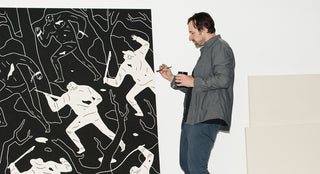The world is fucked up right now. On the day I went up to artist Cleon Peterson’s studio in the exurbs north of L.A., three men killed more than 40 people at Atatürk Airport in Istanbul. A few days later in America, on separate occasions within the span of 48 hours, two black men would be needlessly shot to death by the police. A few days after that, a man would kill five cops in Dallas.
While spiritually taxing, this mess is unsurprising to many of us at this point. Likewise, to Peterson, it’s all cause and effect. “I don’t agree with radical Islamic terrorism, but I can see how that’s developed, because I can see how people want to have a voice in the world today,” Peterson tells me, referring to a sculpture he showed in Belgium last year of a beheading by an executioner—but he might as well be talking about the violence erupting here in the States. “And if you disenfranchise people, and you say that their lives are meaningless, that’s a disempowering and bad position for parts of our population to be in.”
Peterson has been making paintings and sculptures about violence for a few years now. He’s not trying to be moralizing; he’s just painting the darkness he sees—what all of us see—from sun up to sun down. His paintings are stark and minimal, like some child of Matisse and Shephard Fairey (whom Peterson worked under for years, and whom he has collaborated with). They’re mostly black-and-white and filled with references to power and struggle and mortality that they’re as mesmerizing as they are disturbing. Which makes his latest collaboration with high-end furniture company Modernica—a daybed on which the printed fabric is a melee of brawling figures—all the more strange. I think it’s pretty amazing that it happened at all, considering the uncompromising subject matter Peterson is working with.
He’d just gotten back from Edmonton, Alberta, when I dropped by, and I watched him as he signed a big stack of prints he’d just put out called “The Genocide” that are available on his website. Pretty soon we were talking openly about his seedy past, and his thoughts on American apathy and racism.
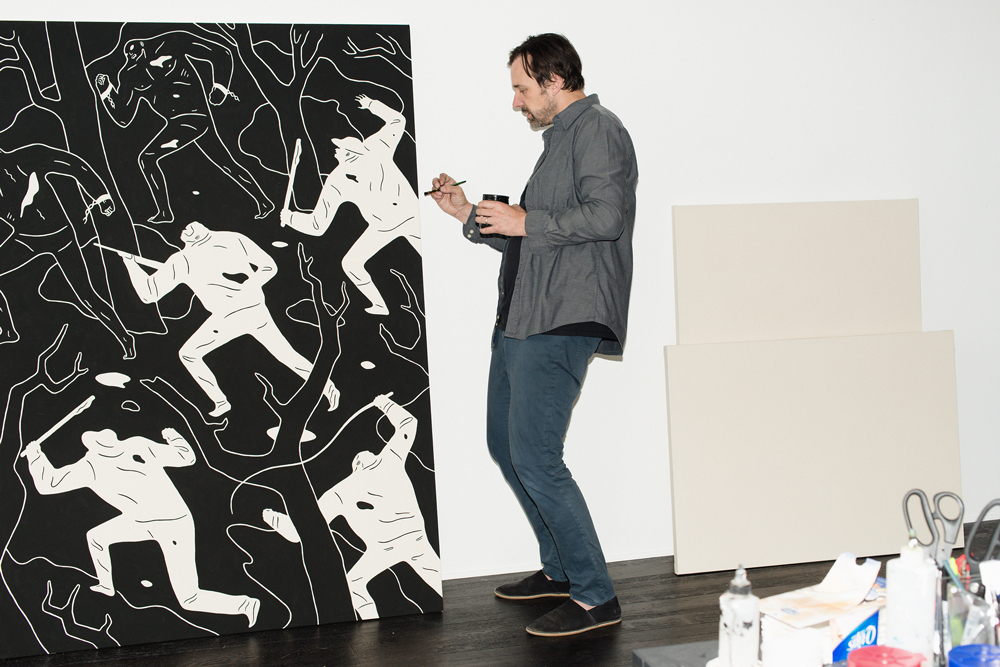
MAXWELL WILLIAMS: What were you doing in Edmonton?
CLEON PETERSON: Somebody paid me to go up there and paint a mural.
There must be different reads and reactions to your work in different places—a place like Edmonton versus a place like, say, Belgium or Hong Kong, where you recently showed?
Absolutely. Edmonton is a weird place. I’d say their art community is conservative and local. I think a lot of times when you go to smaller places, it’s about local craft, and many people don’t have full-on historical educations where they can contextualize art, but they more appreciate it on a surface level. It’s actually more interesting, because you get an honest reaction. They won’t think, “Oh, if I say this, I’m going to sound stupid.”
Did anyone say anything that surprised you while you were up there?
You know, most of the time, people don’t say stuff to me about the work. At first, when I was doing the work, I thought, “Oh, I’m putting some violence up in the world, and I expect people to come by and be critical.” But people, generally, don’t have that much courage to exercise their voice. That’s the funny thing about art: If people don’t understand exactly what you’re doing, they might think it’s some kind of deficiency within themselves.
Do you want people to come at you?
I think it’d be fine. I respect people that have opinions and are looking at the work critically. Even if they’re having a gut reaction and they hate the work, at least they’re feeling something.
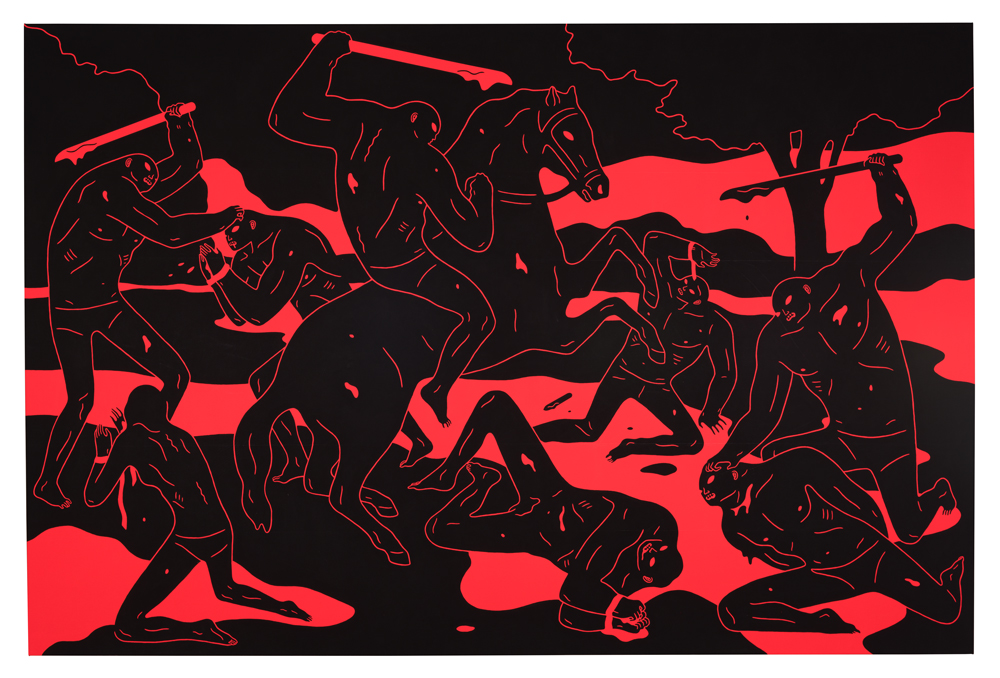
A River of Blood
You told South China Morning Post, “People today, in the U.S. especially, have become non-participatory as far as what’s going on in the world. We see violence and war in the media but people don’t feel like it’s your life—or has anything to do with you, but of course we are very much part of it.” Does art combat apathy in some way?
Art has a special power that, say, the media doesn’t have: it asks the individual to participate in creating meaning. When you look at the piece of work, it’s up to you to figure out what’s going on. Whereas you can see stuff in the news, and you can just passively watch it, and think that it doesn’t really apply to you. But if an artwork is interesting enough that it actually draws you in, and you become part of it, and you interject your worldview on whatever the artwork is about, then that’s great. I like people to have opinions.
Are you aiming to confront people with your paintings?
Unapologetically. It’s not like it has to be justified. I’m not an advocate for violence, but I am an advocate for people being un-apathetic in the world today. I’m not a do-gooder, per se—I’m just documenting the world as I see it. I don’t have a super-optimistic view of what’s happening. I don’t think technology equals progress, equals all of us getting along in the future, equals world peace. There’s some fucked up shit out there, and it’s better to talk about it and confront it than to just ignore it.
“There’s some fucked up shit out there, and it’s better to talk about it and confront it than to just ignore it.”
A lot of people ask me, because I’ve got three kids that are 9, 7, and 4, “What about your kids? Are they fucked up from your art? Does what you paint expose them to the world and all this darkness?” I look back on my childhood, and there was never a time when my grandparents and my parents and I didn’t talk about what was going on. And I think that just being able to have a dialogue, and to be able to see the world as it is, is super important in being a balanced human being.
Because you could paint a pretty picture, and you grow up not realizing there’s all this fucked up shit in the world, and then you can’t deal with it.
Yeah, and I feel like the United States, in our essence, we’re puritanical. We’re all about avoiding cognitive conflict. Anything that doesn’t completely make sense, and come out in a do-goody way, we just want to avoid.

The Grave Diggers
You’re obviously not an advocate for violence—that’s a given. But you told Paradigm Magazine, in relation to ‘The Judgement’ at PLUS ONE Gallery in Belgium, which included a sculpture of a beheading, “I think that the world and people’s motives are exceedingly complex and what seems heroic and just on one side is often the opposite on the other.” This could be read as you trying to empathize with, say, Daesh, for instance. Is there empathy towards violence and those who perform violence in your work?
I think I have empathy towards people that are generally disenfranchised. Just because I’ve been through life situations where I’ve been “the other” or “deviant” or not part of society. That’s a comfortable place for me to live in. I don’t mind being in that world. But I think that you look at immigrants that are coming to Europe or the United States, and how they’re always going to have a really tough time integrating, and also financially, the status they can hold in ‘our world.’ So it totally seems rational to me that there would be a reaction to that and an anger, and I think that through an empathizing with the situation that these people are in, maybe that could be a solution in the future.
I’ve always felt that too. We’re not in positions of power, but the more we ignore it, then people who are in positions of power are going to continue to disenfranchise people, and it’s going to get worse, until that anger or violence happens.
I just watched the OJ documentary on ESPN. It’s fucking amazing. And it’s not about OJ, it’s about the race situation in the United States, which is a subject that’s totally neglected and not confronted at all. We do things on a surface level. We have Martin Luther King Day. But racism today has become systemic and deeply rooted within economics and politics and housing developments and the jail system. There’s so many layers of unfairness, and you see how shit boils up.
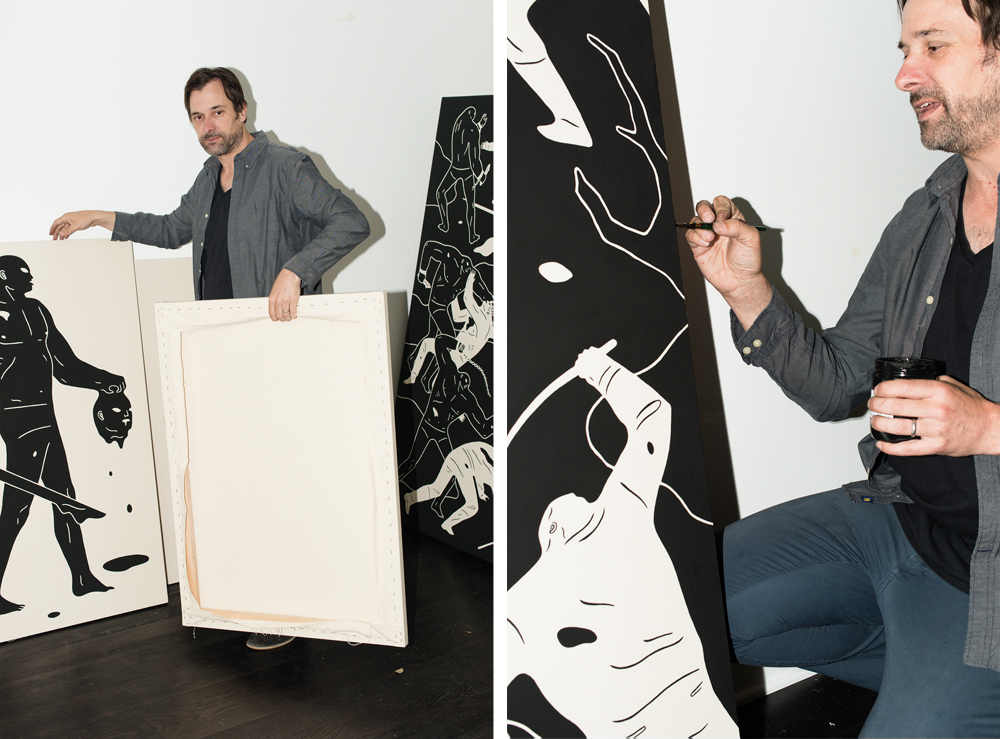
You were just talking about how your empathy comes from being an outsider. In an interview, you said, about some of your work from a few years ago: “The cityscapes are based in true, personal stories of drug addiction and life in the streets of New York City in the 1990s.” Can you give me an example of what some of the works you were narrating were about?
Police violence, drug addicts burning each other to come up with little bits of money, violence on the street—something I’d seen a lot of. I was robbed at gunpoint three times. This is the shit that you grow up with if you’re in that lifestyle. All of your friends are fucked up, and your morals and ethics bend and twist, and then eventually you wake up and you’re in jail, or you’re living out of a car, which is what happened to me.
Was there a moment where you were like, “I’ve got to stop this”?
Yeah, they gave me three felonies. They were like, “You have a choice of get sober and life in a halfway house and fly straight, or go to prison for three years.” That was my decision. Once you get wrapped up in the jail system, you’re fucked. So, I changed at that point. I was in there with people that robbed banks, and other people who played for the Raiders or city councilmen that got wrapped up in heroin. And you’re like, “These people aren’t really that different from me; it’s just a matter of sticking around for a little bit longer, and then all of a sudden you’ve got 15 years in prison.”
“One of the main inspirations that I have is anger.”
Were you making art at the time?
Yeah, I was making art. I was working for the skateboard industry making skateboards. I was totally fucked up, but I always worked. I would steal stuff and write bad checks, but I was lucky that I had a job.
Your work is divorced from specifics. Can you talk about this?
For whatever reason, that’s how I’ve developed what I do. One of the main inspirations that I have is anger. If I can be angry about something, it means I feel passionate about it. It makes me want to make art about it. I try to not be specific because I don’t want to one-to-one draw things, and illustrate situations. There’s more to it than being a story about violence, there’s also form and composition and gesture and emotion. But there are cues that point to historic events. Like this work here is about slavery. They are some paintings that Usher commissioned me to do. There’s a series of five of them, and it’s about a slave revolt. It does get specific, but in a general way. Because I feel that it’s more approachable if it isn’t about a specific situation.
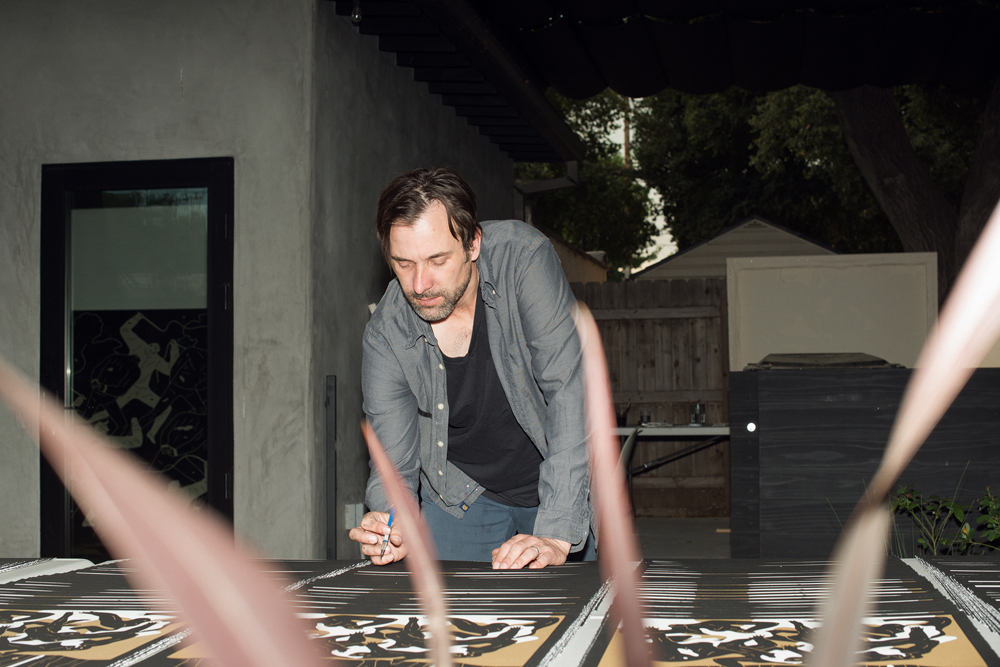
Like this isn’t Nat Turner’s rebellion, it’s a slave revolt in general.
Yeah, in general. It’s not even nailed down in time. [Points to a painting of men with weapons standing in front of bodies piled up in a mass grave] Like this situation here could be today or a few hundred years ago. It could be in the United States or it could be in Africa or anywhere—I like that ambiguity.
With the Modernica daybed: what is that, for you, to put these images on something that’s a commercial product? There’s an irony to these violent images on a daybed.
That’s why I like it. And the same thing goes for putting images on walls in the street. I don’t think of myself as a “street artist” or somebody that does work in that vein, but I love the idea of doing large paintings that confront people. So furniture is about beauty and form, and my stuff, a lot of the time, I’d be happy if people hated it. That was a goal of mine at first was to make something that was not easy. I don’t want to make shit that’s easy or beautiful or next to your parents’ flowers. So doing a juxtaposition with furniture is cool, because it’s unexpected.
***
Photos by Nathanael Turner.

